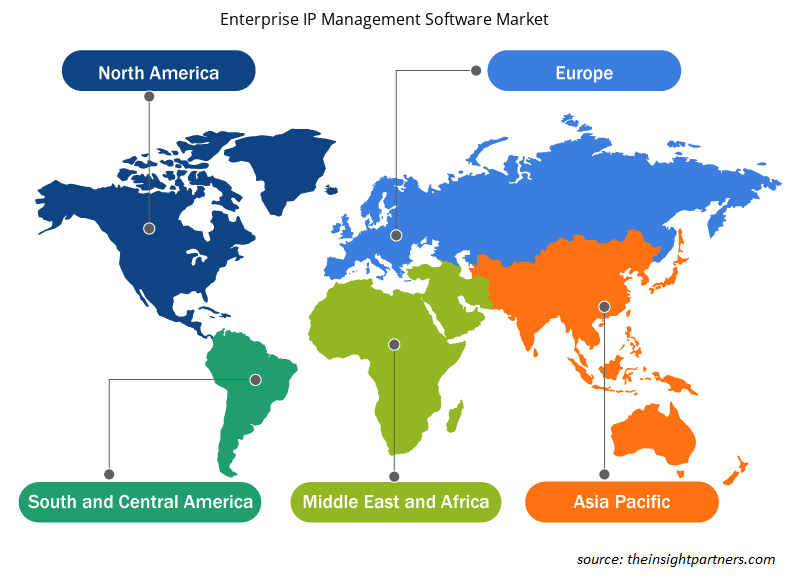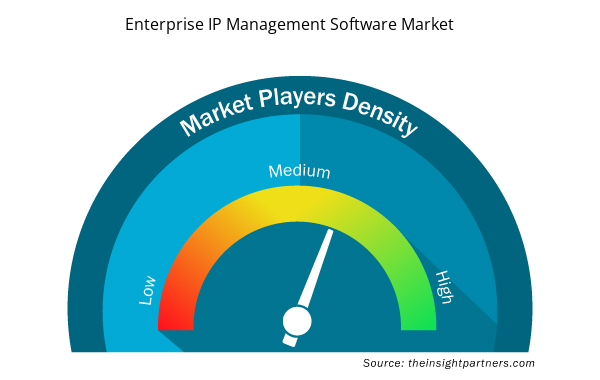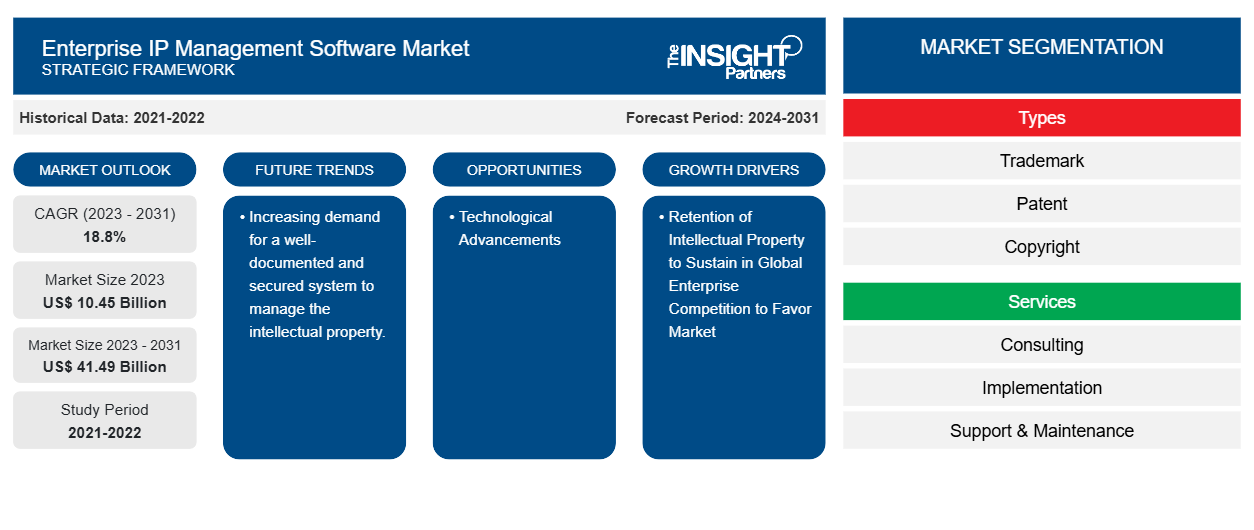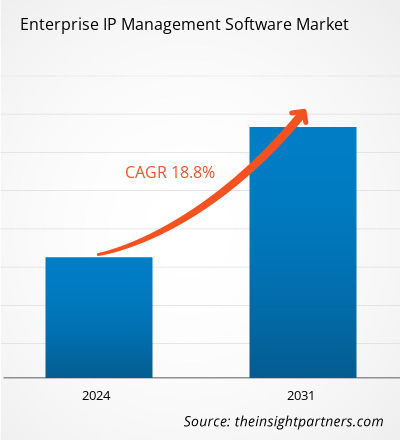エンタープライズ IP 管理ソフトウェアの市場規模は、2023 年の 104.5 億米ドルから 2031 年には 414.9 億米ドルに達すると予測されています。市場は 2023 年から 2031 年にかけて 18.8% の CAGR を記録すると予想されています。世界的な企業競争に耐えるための知的財産の保持と、新しい配信チャネルの増加は、今後もエンタープライズ IP 管理ソフトウェア市場の主要なトレンドであり続けると思われます。
エンタープライズ IP 管理ソフトウェア市場分析
ビジネス IP 管理ソフトウェアの市場は、ここ数年で急成長し、かなりの速度で導入されてきました。この傾向は今後も続くと予想されています。グローバル化時代の発展途上国は、経済発展のために知的財産 (IP) に依存しています。アジア太平洋地域の発展途上国は、知的財産 (IP) の価値、その必要性、そしてそれが商業と投資に与える影響を認識し始めています。国際関係 (IR) がもたらす多くの利点にもかかわらず、ほとんどのアジア太平洋諸国では知的財産権を発行および施行するために必要な手続きが欠如しており、それが企業にとってさらに大きな損失を引き起こしています。
エンタープライズ IP 管理ソフトウェア市場の概要
商標や特許を所有している、または取得を希望している企業は、知的財産管理ソフトウェアを活用します。知的財産管理ソフトウェアは、弁護士や知的財産法律事務所が知的財産の申請や訴訟を計画、実行、および結果を出すのにも役立ちます。
要件に合わせてレポートをカスタマイズする
このレポートの一部、国レベルの分析、Excelデータパックなど、あらゆるレポートを無料でカスタマイズできます。また、スタートアップや大学向けのお得なオファーや割引もご利用いただけます。
- このレポートの主要な市場動向を入手してください。この無料サンプルには、市場動向から見積もりや予測に至るまでのデータ分析が含まれます。
エンタープライズ IP 管理ソフトウェア市場の推進要因と機会
グローバル企業競争で生き残るための知的財産の保持が市場を有利にする
知的財産資産は、企業間の競争を促進し維持するための重要かつ適応性の高いツールです。グローバル化と貿易の自由化によってもたらされた最も重要なことは、中小企業であっても、たとえ国内のローカル市場で事業を展開している場合でも、すべての企業が世界規模で競争力を持つようになったことです。中小企業が競争力を維持するには、明確な事業計画が必要です。研究開発への投資、新技術の獲得、より優れたデザインの作成、商品のマーケティングの成功など、さまざまな手段を通じて、生産性を継続的に向上させ、生産コストを下げ、製品ラインの評判を向上させる必要があります。
技術の進歩
技術の進歩により、企業向け知的財産管理ソフトウェアの既存の市場が一変し、新たなビジネスの可能性が開かれ、顧客の行動が変化する可能性があります。競争力を維持したい企業は、技術の進歩に遅れずについていく必要があります。
エンタープライズ IP 管理ソフトウェア市場レポートのセグメンテーション分析
エンタープライズ IP 管理ソフトウェア市場分析の導出に貢献した主要なセグメントは、タイプ、サービス、およびエンドユーザーです。
- タイプ別に見ると、エンタープライズ IP 管理ソフトウェア市場は、商標、特許、著作権、意匠、訴訟に分類されます。商標セグメントは予測期間中に成長すると予想されます。
- サービス別に見ると、市場はコンサルティング、実装、サポートとメンテナンスに分かれています。コンサルティング部門は予測期間中に成長すると予想されています。
- エンドユーザーに基づいて、エンタープライズ IP 管理ソフトウェア市場は、BFSI、製薬、自動車、航空宇宙および防衛、情報技術、研究機関に分かれています。BFSI セグメントは予測期間中に成長すると予想されます。
エンタープライズ IP 管理ソフトウェアの地域別市場シェア分析
エンタープライズ IP 管理ソフトウェア市場レポートの地理的範囲は、主に北米、アジア太平洋、ヨーロッパ、中東およびアフリカ、南米/中南米の 5 つの地域に分かれています。北米はエンタープライズ IP 管理ソフトウェア市場を支配してきました。北米地域のさまざまな業界でのハイテク採用の傾向が、エンタープライズ IP 管理ソフトウェア市場の成長を後押ししています。デジタル ツールの採用の増加や政府機関による高い技術支出などの要因が、北米のエンタープライズ IP 管理ソフトウェア市場の成長を牽引すると予想されています。さらに、米国とカナダの先進国では研究開発に重点が置かれているため、北米のプレーヤーは技術的に高度なソリューションを市場に投入せざるを得ません。さらに、米国には多くのエンタープライズ IP 管理ソフトウェア市場のプレーヤーがおり、革新的なソリューションの開発にますます重点を置いています。これらすべての要因が、この地域のエンタープライズ IP 管理ソフトウェア市場の成長に貢献しています。
エンタープライズ IP 管理ソフトウェア市場の地域別分析
予測期間を通じてエンタープライズ IP 管理ソフトウェア市場に影響を与える地域的な傾向と要因は、Insight Partners のアナリストによって徹底的に説明されています。このセクションでは、北米、ヨーロッパ、アジア太平洋、中東およびアフリカ、南米および中米にわたるエンタープライズ IP 管理ソフトウェア市場のセグメントと地理についても説明します。

- エンタープライズIP管理ソフトウェア市場の地域別データを入手
エンタープライズIP管理ソフトウェア市場レポートの範囲
| レポート属性 | 詳細 |
|---|---|
| 2023年の市場規模 | 104.5億米ドル |
| 2031年までの市場規模 | 414.9億米ドル |
| 世界のCAGR(2023年~2031年) | 18.8% |
| 履歴データ | 2021-2022 |
| 予測期間 | 2024-2031 |
| 対象セグメント | タイプ別
|
| 対象地域と国 | 北米
|
| 市場リーダーと主要企業プロフィール |
|
エンタープライズ IP 管理ソフトウェア市場のプレーヤー密度: ビジネス ダイナミクスへの影響を理解する
エンタープライズ IP 管理ソフトウェア市場は、消費者の嗜好の変化、技術の進歩、製品の利点に対する認識の高まりなどの要因により、エンドユーザーの需要が高まり、急速に成長しています。需要が高まるにつれて、企業は提供を拡大し、消費者のニーズを満たすために革新し、新たなトレンドを活用し、市場の成長をさらに促進しています。
市場プレーヤー密度とは、特定の市場または業界内で活動している企業または会社の分布を指します。これは、特定の市場スペースに、その規模または総市場価値と比較して、どれだけの競合相手 (市場プレーヤー) が存在するかを示します。
エンタープライズ IP 管理ソフトウェア市場で事業を展開している主要企業は次のとおりです。
- アナクア株式会社
- クラリベイト
- ウェブTMS
- カーディナル・インテレクチュアル・プロパティ社
- パトリックスAB
- フレックスタルク
免責事項:上記の企業は、特定の順序でランク付けされていません。

- エンタープライズIP管理ソフトウェア市場のトップキープレーヤーの概要を入手
エンタープライズ IP 管理ソフトウェア市場のニュースと最近の動向
エンタープライズ IP 管理ソフトウェア市場は、重要な企業出版物、協会データ、データベースを含む一次調査と二次調査後の定性的および定量的データを収集することによって評価されます。市場の動向の一覧は次のとおりです。
- 2023年2月、ソフトウェアに特化したプライベートエクイティファームであるResurgens Technology Partnersは、同社のポートフォリオ企業であり、イノベーションおよびIP管理ソフトウェアの大手プロバイダーであるWellspringが、技術移転および知的財産管理の大手コンサルティングおよびサービス企業であるIP Pragmaticsの買収を完了したことを発表しました。
(出典:Resurgens Technology Partners、プレスリリース、2023年)
- イノベーションと知的財産管理テクノロジーの大手プロバイダーであるアナクアは、2022年4月に、企業や法律事務所向けのAQX IP管理サービスの一環として、新しい自動情報開示ソリューションをリリースする計画を発表しました。この新しいシステムは、IDSプロセスを合理化および自動化することで、IP専門家が時間とコストを節約するのに役立ちます。
(出典:アナクア、プレスリリース、2022年)
エンタープライズ IP 管理ソフトウェア市場レポートの対象範囲と成果物
「エンタープライズ IP 管理ソフトウェア市場の規模と予測 (2021 ~ 2031 年)」レポートでは、以下の分野をカバーする市場の詳細な分析を提供しています。
- 対象範囲に含まれるすべての主要市場セグメントの世界、地域、国レベルでの市場規模と予測
- 市場の動向(推進要因、制約、主要な機会など)
- 今後の主な動向
- 詳細なPEST/ポーターの5つの力とSWOT分析
- 主要な市場動向、主要プレーヤー、規制、最近の市場動向を網羅した世界および地域の市場分析
- 市場集中、ヒートマップ分析、主要プレーヤー、最近の動向を網羅した業界の状況と競争分析
- 詳細な企業プロフィール
- 過去2年間の分析、基準年、CAGRによる予測(7年間)
- PEST分析とSWOT分析
- 市場規模価値/数量 - 世界、地域、国
- 業界と競争環境
- Excel データセット


- Diaper Packaging Machine Market
- Mice Model Market
- Authentication and Brand Protection Market
- Predictive Maintenance Market
- Advanced Planning and Scheduling Software Market
- Ceramic Injection Molding Market
- Hydrogen Storage Alloys Market
- Green Hydrogen Market
- Digital Language Learning Market
- Thermal Energy Storage Market

Report Coverage
Revenue forecast, Company Analysis, Industry landscape, Growth factors, and Trends

Segment Covered
This text is related
to segments covered.

Regional Scope
North America, Europe, Asia Pacific, Middle East & Africa, South & Central America

Country Scope
This text is related
to country scope.
よくある質問
The global enterprise IP management software market is expected to reach US$ 41.49 billion by 2031.
The key players holding majority shares in the global enterprise IP management software market are Anaqua, Inc., Clarivate, WebTMS, Cardinal Intellectual Property, Inc., Patrix AB, Flextarc, and Patracode Services Pvt. Ltd, SimpleLegal, Inc., Decision Design Corporation, AppColl.
Technological Advancements are impacting the enterprise IP management software, which is anticipated to play a significant role in the global enterprise IP management software market in the coming years.
Retention of intellectual property to sustain in global enterprise competition and the rising number of new channels of delivery are the major factors that propel the global enterprise IP management software market growth.
The global enterprise IP management software market was estimated to be US$ 10.45 billion in 2023 and is expected to grow at a CAGR of 18.8% during the forecast period 2024 - 2031.
Trends and growth analysis reports related to Technology, Media and Telecommunications : READ MORE..
The Insight Partners performs research in 4 major stages: Data Collection & Secondary Research, Primary Research, Data Analysis and Data Triangulation & Final Review.
- Data Collection and Secondary Research:
As a market research and consulting firm operating from a decade, we have published and advised several client across the globe. First step for any study will start with an assessment of currently available data and insights from existing reports. Further, historical and current market information is collected from Investor Presentations, Annual Reports, SEC Filings, etc., and other information related to company’s performance and market positioning are gathered from Paid Databases (Factiva, Hoovers, and Reuters) and various other publications available in public domain.
Several associations trade associates, technical forums, institutes, societies and organization are accessed to gain technical as well as market related insights through their publications such as research papers, blogs and press releases related to the studies are referred to get cues about the market. Further, white papers, journals, magazines, and other news articles published in last 3 years are scrutinized and analyzed to understand the current market trends.
- Primary Research:
The primarily interview analysis comprise of data obtained from industry participants interview and answers to survey questions gathered by in-house primary team.
For primary research, interviews are conducted with industry experts/CEOs/Marketing Managers/VPs/Subject Matter Experts from both demand and supply side to get a 360-degree view of the market. The primary team conducts several interviews based on the complexity of the markets to understand the various market trends and dynamics which makes research more credible and precise.
A typical research interview fulfils the following functions:
- Provides first-hand information on the market size, market trends, growth trends, competitive landscape, and outlook
- Validates and strengthens in-house secondary research findings
- Develops the analysis team’s expertise and market understanding
Primary research involves email interactions and telephone interviews for each market, category, segment, and sub-segment across geographies. The participants who typically take part in such a process include, but are not limited to:
- Industry participants: VPs, business development managers, market intelligence managers and national sales managers
- Outside experts: Valuation experts, research analysts and key opinion leaders specializing in the electronics and semiconductor industry.
Below is the breakup of our primary respondents by company, designation, and region:

Once we receive the confirmation from primary research sources or primary respondents, we finalize the base year market estimation and forecast the data as per the macroeconomic and microeconomic factors assessed during data collection.
- Data Analysis:
Once data is validated through both secondary as well as primary respondents, we finalize the market estimations by hypothesis formulation and factor analysis at regional and country level.
- Macro-Economic Factor Analysis:
We analyse macroeconomic indicators such the gross domestic product (GDP), increase in the demand for goods and services across industries, technological advancement, regional economic growth, governmental policies, the influence of COVID-19, PEST analysis, and other aspects. This analysis aids in setting benchmarks for various nations/regions and approximating market splits. Additionally, the general trend of the aforementioned components aid in determining the market's development possibilities.
- Country Level Data:
Various factors that are especially aligned to the country are taken into account to determine the market size for a certain area and country, including the presence of vendors, such as headquarters and offices, the country's GDP, demand patterns, and industry growth. To comprehend the market dynamics for the nation, a number of growth variables, inhibitors, application areas, and current market trends are researched. The aforementioned elements aid in determining the country's overall market's growth potential.
- Company Profile:
The “Table of Contents” is formulated by listing and analyzing more than 25 - 30 companies operating in the market ecosystem across geographies. However, we profile only 10 companies as a standard practice in our syndicate reports. These 10 companies comprise leading, emerging, and regional players. Nonetheless, our analysis is not restricted to the 10 listed companies, we also analyze other companies present in the market to develop a holistic view and understand the prevailing trends. The “Company Profiles” section in the report covers key facts, business description, products & services, financial information, SWOT analysis, and key developments. The financial information presented is extracted from the annual reports and official documents of the publicly listed companies. Upon collecting the information for the sections of respective companies, we verify them via various primary sources and then compile the data in respective company profiles. The company level information helps us in deriving the base number as well as in forecasting the market size.
- Developing Base Number:
Aggregation of sales statistics (2020-2022) and macro-economic factor, and other secondary and primary research insights are utilized to arrive at base number and related market shares for 2022. The data gaps are identified in this step and relevant market data is analyzed, collected from paid primary interviews or databases. On finalizing the base year market size, forecasts are developed on the basis of macro-economic, industry and market growth factors and company level analysis.
- Data Triangulation and Final Review:
The market findings and base year market size calculations are validated from supply as well as demand side. Demand side validations are based on macro-economic factor analysis and benchmarks for respective regions and countries. In case of supply side validations, revenues of major companies are estimated (in case not available) based on industry benchmark, approximate number of employees, product portfolio, and primary interviews revenues are gathered. Further revenue from target product/service segment is assessed to avoid overshooting of market statistics. In case of heavy deviations between supply and demand side values, all thes steps are repeated to achieve synchronization.
We follow an iterative model, wherein we share our research findings with Subject Matter Experts (SME’s) and Key Opinion Leaders (KOLs) until consensus view of the market is not formulated – this model negates any drastic deviation in the opinions of experts. Only validated and universally acceptable research findings are quoted in our reports.
We have important check points that we use to validate our research findings – which we call – data triangulation, where we validate the information, we generate from secondary sources with primary interviews and then we re-validate with our internal data bases and Subject matter experts. This comprehensive model enables us to deliver high quality, reliable data in shortest possible time.


 このレポートの無料サンプルを入手する
このレポートの無料サンプルを入手する